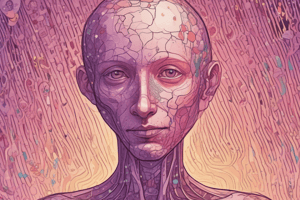Podcast
Questions and Answers
What is Carcinogenesis and types?
What is Carcinogenesis and types?
the molecular basis of cancer. Proto-oncogenes to oncogenes indice transferred phenotype when expelled in cell promoting growth. Tumor suppressor gene prevents uncontrolled growth. Gene regulator apoptosis enhances cell survival rather than stimulating proliferation. Gene regulatory interaction is between host and tumor cells.
Genetic lesion in cancer?
Genetic lesion in cancer?
Can be from point mutation or chromosome. They can be drivers or passengers. Point mutation activates or inactivates a protein product of affected genes.
What is driver and passenger mutations
What is driver and passenger mutations
Driver mutation is pathogenic, comes from altered function of cancer gene directly contributes to development of progression of cancer. Passenger mutations create genetic variants that can provide tumor cells with selective advantage in setting of therapy.
What is Neoplasia and neoplastic cells?
What is Neoplasia and neoplastic cells?
What is the composition of a tumor?
What is the composition of a tumor?
What are the growth factors involved in cancer?
What are the growth factors involved in cancer?
What is RAS?
What is RAS?
What is BCR ABL translocation?
What is BCR ABL translocation?
What is the TP53 Guardian Gene?
What is the TP53 Guardian Gene?
What are the signs of cancer?
What are the signs of cancer?
What are seem cancer signs in children?
What are seem cancer signs in children?
Flashcards
Carcinogenesis
Carcinogenesis
The molecular basis of cancer, involving proto-oncogenes transforming into oncogenes, tumor suppressor genes preventing uncontrolled growth, and gene regulators influencing apoptosis.
Genetic Lesions in Cancer
Genetic Lesions in Cancer
Genetic alterations in cancer cells, which can be point mutations or chromosome changes, and classified as either drivers (pathogenic) or passengers.
Driver Mutation
Driver Mutation
Pathogenic mutations that directly contribute to the development and progression of cancer by altering the function of cancer-related genes.
Passenger Mutation
Passenger Mutation
Signup and view all the flashcards
Neoplasia
Neoplasia
Signup and view all the flashcards
Tumor Composition
Tumor Composition
Signup and view all the flashcards
Growth Factors in Cancer
Growth Factors in Cancer
Signup and view all the flashcards
RAS
RAS
Signup and view all the flashcards
BCR-ABL Translocation
BCR-ABL Translocation
Signup and view all the flashcards
TP53 'Guardian Gene'
TP53 'Guardian Gene'
Signup and view all the flashcards
Signs of Cancer
Signs of Cancer
Signup and view all the flashcards



